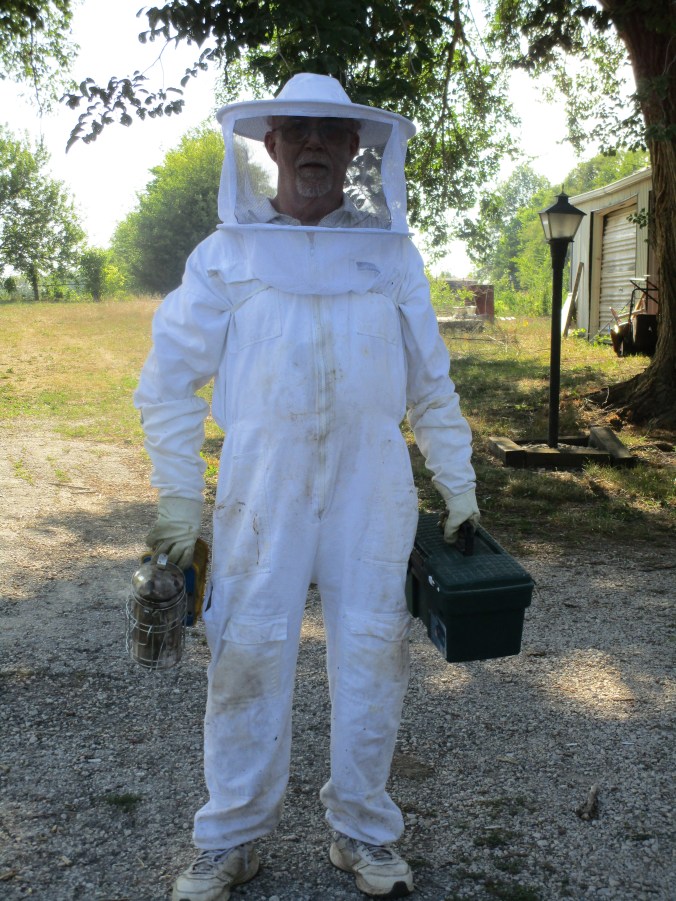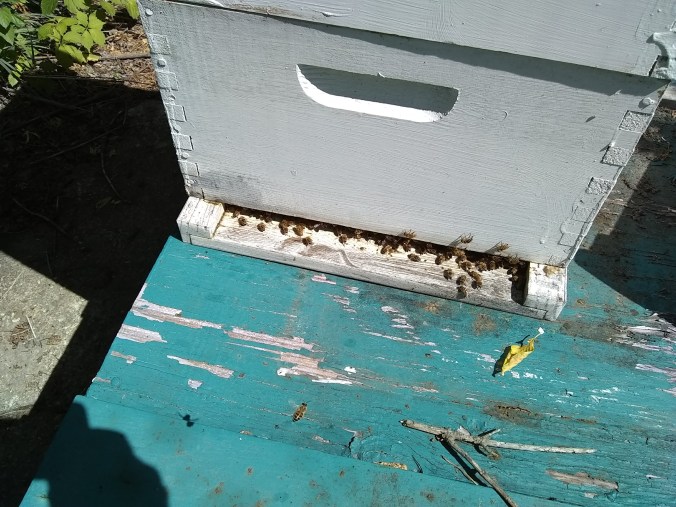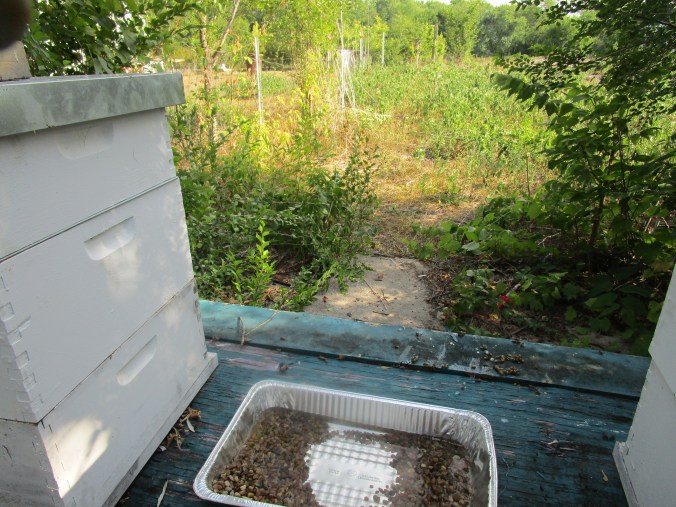Much of what we have talked about in this series of Eight Endangered Skills can be summed up with the phrase “making do”. It means using what you have to meet your needs. When the people we know as the pioneers made their way across this country in covered wagons, they built their homes in places where there were no stores, and the neighbors were miles away. All they had was what they brought with them in that wagon, and what they could get from the land around them. They had to make do with what was available to them. Learning how to do that was often a matter of life and death.
Those lessons were passed down to their children, and in many cases, forgotten when life got easier. Many of our our grandparents and great-grandparents relearned them from living through the Great Depression. Again, those lessons have largely been forgotten. We really need to work on reeducating ourselves.
Today, for most of us, especially here in America, it is pretty easy to just go buy what we need. Even if we can’t get it today, we’ll be able to on pay day, right? Well, what if we couldn’t? What if there was no money to go to the store, and there wasn’t going to be any soon? Worse yet, what if there was no store to go to even if we had money? Then what do we do? Well, no, we’re not living that scenario now, and we may not any time soon, but I wouldn’t want to wait until we are, to figure out what I might need to do to survive.
While money is available, at its simplest, making do means spending frugally, and living within your means. Don’t spend what you don’t have. Get out of debt and stay out. If you don’t NEED it, don’t buy it. Just in case some of you need a refresher on needs and wants, let’s put it this way: You need to eat, you don’t need to eat ice cream. You may want to eat ice cream, but you don’t need it. Seriously think about your wants and needs. Do you need new shoes now, or do you just want a new pair. Can you fix what you have? If not then by all means, go buy it, but be a smart shopper and look for real value. That might even mean spending a little more for something that will last a lot longer. Buy the best you can afford, but make sure you can afford it. Buying “cheap” can really cost in the long run. There is an old saying that goes “you get what you pay for”, and it’s true.
Closely related to spending frugally is to take good care of what you have. Make sure you eat that healthy food that you bought. Having to throw out food because it spoiled before we ate it is super frustrating for me. It’s like pouring money down the drain, or into the compost pile. Buy the best food you can afford, or better yet, learn to grow it, preserve it and cook it yourself. Yes, that might mean spending some money initially, but you will save much more in the long run. Take good care of your belongings. Put tools away when you’re finished with them instead of leaving them somewhere where they might be lost, or ruined (like out in the yard where they can be rained on or run over!). I could go on and on, but I’m sure you get the idea.
Let me stop here and say that Ed and I are just as guilty as anyone else about this. We try to be good stewards of what God’s given us, but we don’t always succeed. When we don’t, we try to learn from our mistakes and do better next time. We still have a long way to go, but we’re working on it.
One of Ed’s favorite phrases that he picked up in the Army is “improvise, adapt, and overcome”. That is the next part of making do. If you don’t have it, and can’t buy it, you need to use what you have. Many cooks know how to make “emergency substitutions” of missing ingredients. How do you make substitutions for other ingredients you might not have? You use ingredients you do have. You can learn to substitute what you don’t have with something you do in just about any situation. One of my friends told me once about someone using the soles of old shoes to replace broken hinges on a screen door.
My dad says that when he needs something, he makes it. What he is saying is that when he can’t get what he needs, he makes something that will work from what he already has. In order for that to work though, he must have stuff to work with. You have no idea how much stuff he has , but we’ll get to that in a bit.
In order to make do with what you have, you need to have something to make do with. So, the first thing you need to do is think before you throw something away. Ask yourself if that item might be used for some other purpose. If it might, hang on to it. Now before some of you freak out on me, I’m not suggesting that you never throw anything away. There are some things that need to be thrown out, but probably not near as much as you might think. We live in a throw away society, and it’s to our detriment.
Yes, you can take keeping stuff to the extreme. (You can take anything to an unhealthy extreme). I have to make myself purge my supply of junk on occasion before it takes over the house, the garage and the barn, but the thing is that when I need to improvise, I can usually find something that will work. My grandpa (Mom’s dad) was the same way, and he went overboard with what he kept, but he was very, very good at improvising.
There are many advantages to this type of making do. One is that we save money. Another is that we learn to be creative. Once you start exercising that creative muscle, you’ll be amazed at how well you can improvise. A third is that we start to be appreciative of what we have. The more we appreciate what we have, the less we need something more.
In addition to hanging onto some “trash”, you also need to think about learning how to repair what breaks, instead of throwing it away and buying a new one. We’ve already talked about this in another endangered skills post. This also includes learning how to darn socks, sew on buttons, patch clothes, etc. Then when those clothes really do wear out, you can use the rags for other purposes, like rag dolls, rag rugs, or just cleaning rags.
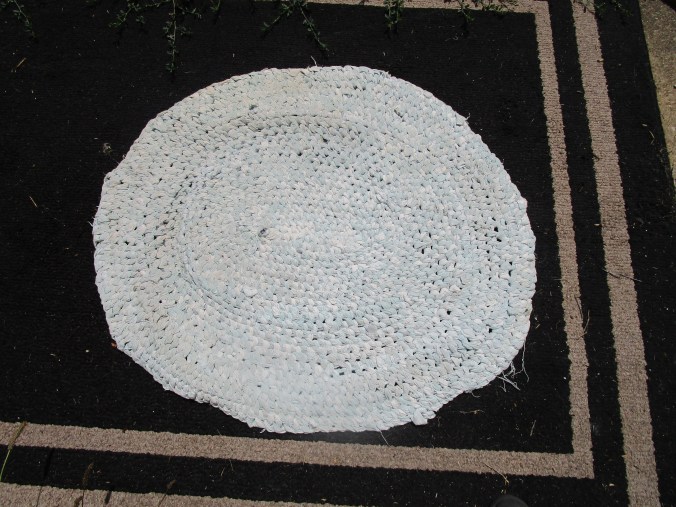
Last winter I made this rag rug for Bam Bam’s room in the basement. It’s made from old flannel sheets, and it’s great for keeping his feet off that cold basement floor.
You could even take it further and learn about appliances and electronics. Not only might you be able to repair things yourself, you could gain an understanding of how the parts work together, and what else might work instead. Bam Bam is really good at that. If you have an aptitude for that kind of thing, you might even build yourself a side business from it. Bartering is always a good way to make do. You trade something you have, or a skill you posses for something you need.
Back to my dad. He was on his own, for the most part, from the time he was about 13, and he learned early how to make do with what he had. Still functionally illiterate, everything he has learned came by watching, listening, and asking questions. He repaired shoes, dug ditches, ran construction equipment and built silos. For many years he worked in what he calls “salvage and demolition”. He and his partner tore down old buildings by hand. Sometimes, he was told he could have whatever was left in the building. In addition to that, he brought home anything from the building that was salvageable. Any time he sees something on the side of the road, he brings it home. He rebuilt an entire house from salvaged materials, and sold it. Last summer, Ed, Chicken Girl and I went to visit my dad in Georgia. It was the first time I had been there in 20 years. It hadn’t really changed that much, there was just more stuff.
He has a workshop down the hill from the house, and then he has other storage buildings that for the most part, aren’t buildings. They are things people wanted rid of, and he was happy to take them off their hands.

This picture was taken from the car port near the house. The house down the hill is actually Dad’s workshop. This is the tip of the iceberg.
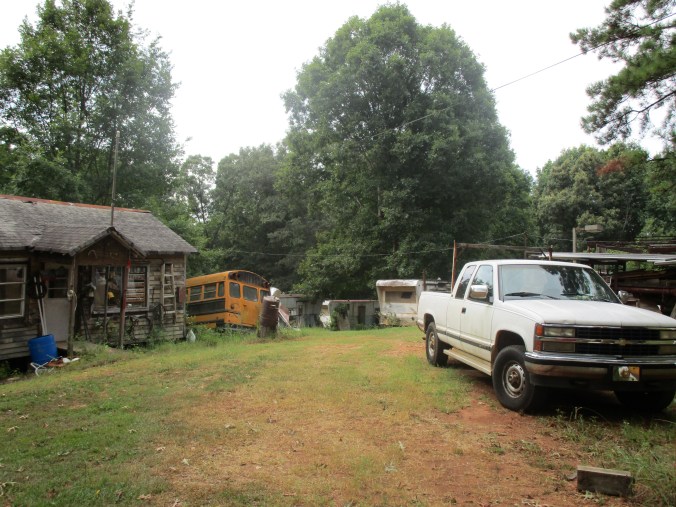
Closer to the work shop. Past the school bus, you can see some trailers. I’ts all used for storage
I took a lot of video. This is just a small sample so you can get the idea. My editing skills aren’t the greatest, and this is a free version of editing software, so, like I said earlier, you get what you pay for. The first part of the video is inside his workshop, the last part is inside one of this many containers. This one has hardware. He has others with antiques, light fixtures, electronics, books, lumber and probably just about anything else you can imagine. I mainly wanted to show you some of the things he has made. Oh, and Dad’s language can be a little coarse so, just be forewarned.
Yeah Dad is the extreme. If you think it’s overwhelming in the video, you should see it in person. I don’t know if you could hear the video all that well, especially in his workshop where the monster fan was running, but everything he showed us, he found either inside a building he was tearing down, in the trash by the side of the road, or someone gave it to him. He keeps it all. If the right buyer comes along, he sells it. If not, he just keeps it until he can make use of it. Oh, and every building on the place has it’s own hammer, screwdriver, pliers, etc., just in case he needs it.
For the rest of us, making do is really a mind set. You have to change how you think. Challenge yourself. How many ways can you make do? Let us know in the comments here, or on our Facebook page.
Connie
Other posts in the Endangered Skills series
Endangered Skill #1: Shoe Repair
Endangered Skill #2: Black Smith
Endangered Skill #3: Small Appliance Repair
Endangered Skill #4: Reading the Weather
Endangered Skills Number 5: Orienteering Part 1
Endangered Skills Number 5: Orienteering Part 2
Endangered Skill #6: Foraging
Endangered Skill 7: Making Your Own Entertainment, Part 1, Musical Instruments
Endangered Skill #7 Making Your Own Entertainment, part 2: Homemade Toys
